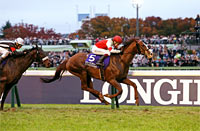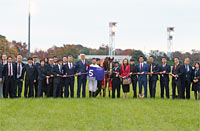Japan Cup (G1) - Data Analysis
Ultimate contest on the 2,400m turf course at Tokyo
The Japan Cup is a ferocious race that has historically attracted world-class competitors such as Prix de l'Arc de Triomphe winners Danedream in 2011 and Solemia in 2012, and consecutive Breeders' Cup Turf winner Conduit in 2009. However, in the 13 years since 2006, the race has been consistently won by Japanese runners. Let’s now analyze some features shared by successful runners in this race based on results over the last 10 years.
Focus on runners that won a JRA graded race last time out
Looking at performances by runners over the last 10 years in terms of finish in their previous race, we note that nine of the 10 winners had finished in the Top 4 of their previous races. In addition, 16 of the 20 Top 2 finishers had also finished in the Top 4 last time out. [Table 1]
[Table 1] Performance by finish in previous race (last 10 years)
Finish in
previous race |
Performance
[1st-2nd-3rd-4th or lower] |
Win ratio |
Top 2 ratio |
Top 3 ratio |
| 1st |
3-3-5-24 |
8.6% |
17.1% |
31.4% |
| 2nd |
2-1-0-25 |
7.1% |
10.7% |
10.7% |
| 3rd |
2-1-1-7 |
18.2% |
27.3% |
36.4% |
| 4th |
2-2-0-14 |
11.1% |
22.2% |
22.2% |
| 5th |
0-1-0-12 |
0% |
7.7% |
7.7% |
| 6th-9th |
1-1-2-32 |
2.8% |
5.6% |
11.1% |
| 10th or lower |
0-1-2-26 |
0% |
3.4% |
10.3% |
In addition, of the 17 runners that had won a JRA graded last time out, 11 finished in the Top 3, achieving a strong Top 3 ratio of 64.7%. In other words, we should check the finish in the previous race, and in the case of runners that have won their previous race, the grade of that race. [Table 2]
[Table 2] Performance by runners that had won a JRA graded race last time out (last 10 years)
Performance
[1st-2nd-3rd-4th or lower] |
Win ratio |
Top 2 ratio |
Top 3 ratio |
| 3-3-5-6 |
17.6% |
35.3% |
64.7% |
Strong performance by runners for which the Japan Cup was the 2nd or 3rd race since August
Looking at performances by runners over the last 10 years in terms of the number of races they had contested since August of the same year, we find that 19 of the 20 Top 2 finishers had contested “1” or “2” such races. In addition, if we limit our analysis to the six years from 2013, the runners that had contested “1” race since August of the same year produced five winners, so we should remember that runners that had contested only “1” race since August have produced more winners in recent years. [Table 3]
[Table 3] Performance by number of races contested since August of same year (last 10 years)
| Number of races |
Performance
[1st-2nd-3rd-4th or lower] |
Win ratio |
Top 2 ratio |
Top 3 ratio |
| 4 or more |
0-0-0-6 |
0% |
0% |
0% |
| 3 |
0-1-0-28 |
0% |
3.4% |
3.4% |
| 2 |
4-5-6-61 |
5.3% |
11.8% |
19.7% |
| 1 |
6-4-4-41 |
10.9% |
18.2% |
25.5% |
| 0 |
0-0-0-4 |
0% |
0% |
0% |
Also check record in spring G1 races
Looking at performances by runners over the last 10 years in terms of their highest finish in a G1 race contested between April and June of the same year, we observe that all 10 winners had finished in the Top 4 of such a race. There was a marked gap in performance between runners that had finished “4th” and “5th” in such a race. In other words, our primary focus should be on runners that have occupied the top places in spring G1 races (rather than runners that have performed well from the summer or runners with a poor record in the spring). [Table 4]
[Table 4] Performance by highest finish in G1 race contested between April and June of same year (last 10 years)
| Highest finish |
Performance
[1st-2nd-3rd-4th or lower] |
Win ratio |
Top 2 ratio |
Top 3 ratio |
| 1st |
4-4-5-18 |
12.9% |
25.8% |
41.9% |
| 2nd |
3-0-1-11 |
20.0% |
20.0% |
26.7% |
| 3rd |
2-1-1-8 |
16.7% |
25.0% |
33.3% |
| 4th |
1-1-0-6 |
12.5% |
25.0% |
25.0% |
| 5th |
0-0-0-6 |
0% |
0% |
0% |
| 6th-9th |
0-2-0-21 |
0% |
8.7% |
8.7% |
| 10th or lower |
0-1-0-20 |
0% |
4.8% |
4.8% |
| No G1 race entered |
0-1-3-50 |
0% |
1.9% |
7.4% |
Also watch trends by horse number
Looking at performances by runners over the last 10 years in terms of horse number, we note that runners with the numbers “1-5” produced six winners. Moreover, runners with the number “1” delivered the three consecutive winners from 2016, the runner-up in 2014, and the third-place finisher in 2015, and have thus consistently finished in the Top 3 over the last five years. However, runners with the numbers “1-5” only produced two runners-up. Meanwhile, third-place finishers have mostly been runners starting in the inner and outer brackets. These may be considered useful statistics when making predictions. [Table 5]
[Table 5] Performance by horse number (last 10 years)
| Horse number |
Performance
[1st-2nd-3rd-4th or lower] |
Win ratio |
Top 2 ratio |
Top 3 ratio |
| 1-5 |
6-2-5-37 |
12.0% |
16.0% |
26.0% |
| 6-10 |
2-4-1-43 |
4.0% |
12.0% |
14.0% |
| 11-18 |
2-4-4-60 |
2.9% |
8.6% |
14.3% |
Seek out the winner!
Focus on time difference with winner in recent defeat
Of the 10 last winners, nine (excluding 2013 winner Gentildonna) either had a difference of 0.3 seconds or less with the winner of a race in which they were defeated within their last two outings, or had won their two previous races. When predicting the winner, we should focus on the finish or time difference with the winner within the two previous races. [Table 6]
[Table 6] Winners’ time difference with winner of race in which they were defeated within last two outings (last 10 years)
| Horse number |
Performance
[1st-2nd-3rd-4th or lower] |
Win ratio |
| 2009 |
Vodka |
0.3s [Tenno Sho (Autumn)] |
| 2010 |
Rose Kingdom |
0.2 [Kikuka Sho (Japanese St. Leger)] |
| 2011 |
Buena Vista |
0.3 [Tenno Sho (Autumn)] |
| 2012 |
Gentildonna |
1st in two previous races |
| 2013 |
Gentildonna |
0.7 [Tenno Sho (Autumn)] |
| 2014 |
Epiphaneia |
0.2 [Tenno Sho (Autumn)] |
| 2015 |
Shonan Pandora |
0.2 [Tenno Sho (Autumn)] |
| 2016 |
Kitasan Black |
No time difference [Takarazuka Kinen] |
| 2017 |
Cheval Grand |
0.1 [Kyoto Daishoten] |
| 2018 |
Almond Eye |
1st in two previous races |
(Michio Kawano)
|




















